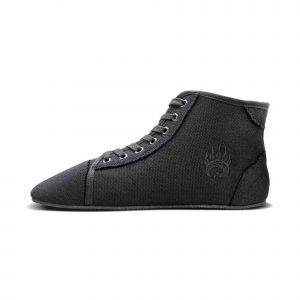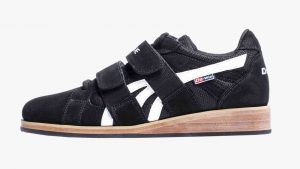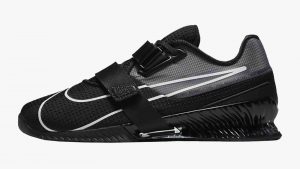While you can technically squat in running shoes, it’s generally not advisable or recommended. The soft soles of running shoes can affect weight distribution, posture, and a variety of other factors that play into effective squats.
When squatting, it is important to have ankle support, which helps you stay balanced. This can be difficult to achieve with running shoes, as they tend not to have a raised heel.
Running shoes also typically have more cushioning in the heel than the front, which can lead to an imbalance in your squat. In addition, the extra cushioning in running shoes can make it difficult to maintain proper form.
For all these reasons, you should generally squat in dedicated footwear or a flat-soled shoe.
In this article, I’ll discuss these factors and others. Let’s begin
Can You Squat in Running Shoes?
If you want to squat correctly, you need the proper shoes. Running shoes with spongy heels or soft cushions can often hinder your ability to achieve proper form and lead to poor results or increased risk of injury.
Shoes designed for weightlifting can often work well for squats and come with features that ensure good traction, stable posture, comfortable interiors, and secure straps.
Opting for one of these types of shoes would be a wise decision regardless of your level of fitness, degree of expertise, or level of experience.
Why You Shouldn’t Squat in Running Shoes
Running shoes come with padding and cushions that assist the action of your feet and legs moving forward.
However, if you’re standing still, bending your knees, and then standing again, you’ll need sure footing and a stable base. Running shoes aren’t built for that.
Here are various ways running shoes can work against you when performing squats.
Going Off Balance
Most running shoes typically have a wide toe box and extra padding. As a result, a soft heel and extra space around your toes may throw you off balance when squatting down with weights.
The arch support on your running shoe can also cause the weight to shift in one direction.
Preferably, you want to minimize the layers between the ground and your feet to prevent this offset.
Difficulty in Squat Depth
Advanced workouts may require you to squat down below your knee level. This level of depth becomes harder if your feet aren’t planted evenly. Running shoes with more heel padding may cause you to lean forward with the added weight.
No Ankle Support
Running shoes have little support for the ankles compared to shoes designed for squats or powerlifting. It’s not a good idea to squat in shoes that don’t protect your anklebone.
As with any exercise, you want the right gear that will prevent injury and work towards executing the workout in the best possible way.
Minimal Technical Feedback
Technical feedback is the ‘feel’ you have from the floor when squatting. Depending on the surface response, you may adjust your posture or technique, which promotes good form and prevents injury. This process becomes difficult if your running shoe has a shock absorber.
Weight distribution in the legs
The squat is an exercise that strains your leg joints if not executed properly. Even leg presses and weightlifting can put excessive pressure on your knees and feet.
Running shoes with arch support is great for runs but cannot transfer weight properly down your legs.
A squat shoe with an even sole distributes weight evenly across your knees and ankles.
Vertical Movement
When it comes to vertical movement, as in the case of squatting, it is important to have a shoe that will allow for easy and comfortable execution.
Running shoes simply do not provide the same level of support and stability as a dedicated squatting shoe or weightlifting shoe.
The heel-to-toe drop is much smaller in a squat shoe, which helps to distribute pressure evenly and keep you balanced.
Additionally, the soles of these shoes are made of rubber rather than foam, which provides better grip and traction.
Finally, the materials used in squat shoes are more durable, ensuring that the shoes will last through multiple workouts.
What are the Best Shoes to Wear for Squats?
Squatting shoes typically provide a flat sole and flat heel and promote stability over soft padding.
According to experts, different shoes in the market qualify for the purpose, but here are the best shoes for squatting.
The Inov-8 Men’s Fastlift 360 Squat Shoes
This khaki-colored squat shoe remains the best overall choice for effective squatting.
It has an external heel cage that offers firm support for your feet. And the classic single strap in the front holds the shoe together, allowing for a full range of motion when executing a squat.
It sports a slightly raised heel but is still low enough for enhanced traction and surface feedback.
At 360g, the Inov-8 is a superlight squat shoe that doesn’t compromise on stability. This shoe remains the top performer for squats and related exercises like lifting weights off the ground or leg presses against a machine.
You will love the style, comfort, and renewed approach to squat exercises you will experience when you buy a pair of Inov-8 Mens Fastlift 360 shoes.
Vivobarefoot Primus Lite III Squat Shoes
The Primus Lite III is ideal if you enjoy a more even footing against the ground when performing squats.
This squat shoe uses recycled material for both sustainability and affordability. The recycled PET surface also comes in mesh fabric, making it comfortable and breathable.
The flat feet of the design implies a level footing and increased stability during squats.
The rubber sole and heels provide comfort and ensure your footing remains planted along the ground’s surface.
Adidas Powerlift 4 Squat Shoes
With their sporty appearance, you could easily mistake these Adidas shoes for a pair of shoes made solely for style and comfort.
The Powerlift 4 sports a comfortable rubber sole that keeps your feet flat and secure as well as promotes easy technical feedback from the ground.
The outer layer of this compact design is made of 100% textile synthetics, ensuring both durability and minimal weight.
The secure hook-and-loop strap brings it all together with stability that average running shoes cannot match.
Bearfoot Ursus Squat Shoes
The Bearfoot Ursus is one of the more affordable items on this list, but it works better than running shoes.
Even training shoes often come with raised-heel designs that make them as uncomfortable as running shoes.
The Ursus cuts right through these cluttering designs by delivering a comfortable pair of shoes with flat feet soles.
There’s no excess padding or unnecessary arch support to derail your stance and posture during squats.
The Bearfoot also has additional points, which most people prefer. These squatting shoes come with a 30-day Money-back Guarantee, and the sleek design makes it a style statement altogether.
Do-Win Classic Squat Shoes
This vintage shoe has an elegant suede design that screams class. The rounded toe ensures that your feet snuggly fit inside. Also, the mesh exterior offers breathability and durability that beats most running shoes.
It comes with stacked leather heels that offer enhanced traction and stability. And you don’t feel the uneasy burden of added weightage compared to when you wear running shoes.
The Do-Win Classic can easily serve as a cross-training shoe thanks to its grip and comfort. And when it’s time for squats, the optimally raised heel and ground feedback kick in to give you the best workout.
What are Some Good Weightlifting shoes for Squats?
Shoes built for weightlifting are sturdy and relatively flat. But they may come with a raised heel of 25mm or less. Similarly, powerlifting shoes will carry toe drops of 20mm or less in most cases.
Unlike running shoes, their primary purpose is not to protect your feet from the impact of running on hard surfaces. Rather, they provide the stability you need when performing squats or any other type of lifting.
Check out my article on Should Weightlifting Shoes Be Tight?
Here are the top weightlifting and powerlifting shoes that work for squats.
Adidas Powerlifts 2.0
This powerlifting shoe by Adidas is at the top when you consider squatting with shoes made for weightlifting.
It comes with a dedicated plat that works towards even weight distribution. The superlight heel support adds more protection compared to wearing running shoes.
The sole also comes with a unique wedge in the middle. And the smooth outsole at the bottom offers more traction and comfort than your average training shoes.
With a synthetic leather exterior and a smooth rubber sole, the Powerlifts 2.0 is the best alternative if you normally wear running shoes for squats.
Reebok Legacy Lifter
The Reebok Legacy Lifter looks as good on the road as it performs in the gym. It features a superior textile exterior that’s breathable and durable.
Plus, it prevents any balancing issues faced when you wear running shoes.
The TPU heels provide a stable posture. And the concentric pattern along the outsole ensures extra grip and unbeatable stability.
Thanks to this tough sole and wide strap on top, it carries better traction than most other training shoes or running shoes.
Nike Romaleos 4
This powerlifting shoe by Nike comes with the average toe drop you can expect in a weightlifting shoe.
But the 20mm drop is much more stable than running shoes with increased arch support and heel base.
It has a wide and stable outsole that houses a rigid midsole in between. And the top straps are wide and adjustable to ensure almost any foot size can fit.
Athletes use the Romaleos 4 not just for weightlifting but for cross-training exercises too.
Puma Fuse
This high-traction shoe is designed primarily for weightlifting. But this build is also what makes it incredibly efficient at squatting.
The shoe’s material is synthetic and fabric, similar to high-end running shoes. But the high-tensile mesh exterior makes it superior to even the most durable running shoe.
The Puma Fuse can withstand everything from additional weight and movement to increased tension or accidental abrasion.
The internal midsole also provides high-density shock absorption without the weight distribution problems posed by training shoes.
Are Squat Shoes Required?
Anyone who has done a proper squat knows that having the right shoes can make a big difference.
The best squat shoes provide support and stability while also helping to keep your feet in the correct position. This is particularly important when you start to add weight, as improper form can lead to injury.
While you can technically squat in any type of shoe, wearing shoes that are specifically designed for squatting will help you to get the most out of your workout and stay safe at the same time.
Is Squatting Barefoot Better Than Running Shoes?
Spongy soles in running shoes aren’t the best bet for squats, so going barefoot sometimes is better if your running shoe has squishy soles.
The reason is that excessive sole mass may affect everything from your form and posture to your stance and lifting ability. So, going barefoot is relatively better in this case.
Also, many lifters prefer lifting barefoot because it gives them unhindered feedback on the floor. This way, they can maneuver or readjust their movements to maintain the right range of motion.
These are not major issues when going for something lighter, like cross-training. But whenever weight is involved, nuances like these make the biggest difference.
Are Squats More Effective When you are barefoot or in shoes?
When it comes to squatting, there is a lot of debate about whether it is more effective to do so with shoes or without.
While there are benefits to both methods, the truth is that squats are most effective when you have the right pair of shoes.
Compared to an ordinary running shoe, a squatting shoe provides additional support and stability, which can help you to avoid injury and increase your range of motion.
In addition, a squatting shoe often has a raised heel, which can help to improve your posture and ensure that your knees stay in alignment.
As a result, if you want to get the most out of your squats, it is important to make sure that you have the right footwear.
Final Thoughts
It is not recommended to squat in running shoes as this can lead to injury. Running shoes are designed for forwarding movement and do not provide the necessary support for squatting.
Additionally, the soles of running shoes are often too soft to provide adequate support when squatting with heavy weights.
If you are serious about squatting, it is best to invest in a pair of dedicated squat shoes, like the Inov-8 FastLift 360. These shoes will provide the support and stability you need to stay safe and maximize your results.









